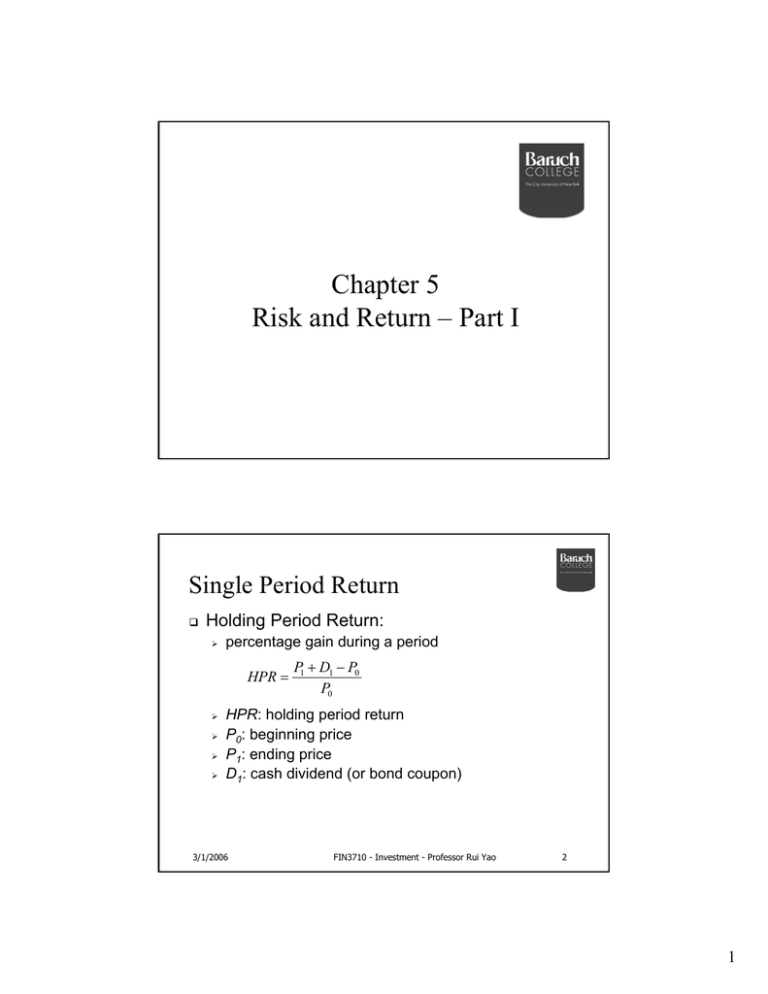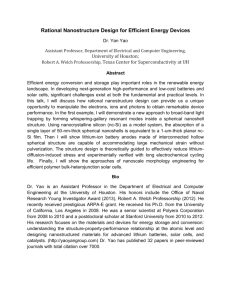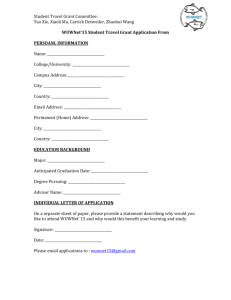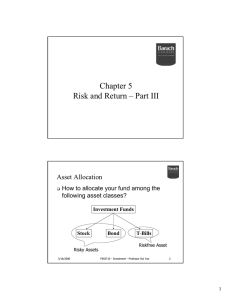Chapter 5 Risk and Return – Part I Single Period Return
advertisement

Chapter 5 Risk and Return – Part I Single Period Return Holding Period Return: ¾ percentage gain during a period HPR = ¾ ¾ ¾ ¾ P1 + D1 − P0 P0 HPR: holding period return P0: beginning price P1: ending price D1: cash dividend (or bond coupon) 3/1/2006 FIN3710 - Investment - Professor Rui Yao 2 1 Probability Distribution of Returns Scenario analysis ¾ A list of possible economic scenarios, the likelihood and HPR associated with each scenario Probability distribution of HPR describes the chances of returns falling to different levels An example of return distribution Economy State (s) Prob: p(s) HPR: r(s) Boom 1 0.25 44% Normal 2 0.50 14% Bust 3 0.25 -16% 3/1/2006 FIN3710 - Investment - Professor Rui Yao 3 Risk Measure Expected Return (µ) ¾ Probability-weighted mean value of HPR E [ r ] = µ = ∑ p ( s ) r ( s ) = [ 0 .25 × 44 % + 0 .5 × 14 % + 0 .25 × ( − 16 %)] = 14 % s Return Variance (σ2) ¾ Probability-weighted squared deviation from mean HPR Var[r ] = σ 2 = ∑ p( s)(r ( s) − E[r ]) 2 s = 0.25 × (.44 − .14) 2 + 0.5 × (.14 − .14) 2 + 0.25 × (−.16 − .14) 2 = 0.045 Standard Deviation (σ) ¾ Square root of the variance SD[r ] ≡ σ = Var[r ] = 0.045 = 0.2121 = 21.21% 3/1/2006 FIN3710 - Investment - Professor Rui Yao 4 2 Multi-period Return Consider a mutual fund Assets at the start HPR(%) Assets before net inflow Net Inflow Assets in the end ¾ ¾ 1Q 1.0 0.10 1.1 0.1 1.2 2Q 1.2 0.25 1.5 0.5 2.0 3Q 2.0 -0.20 1.6 -0.8 0.8 4Q 0.8 0.25 1.0 0.0 1.0 Net inflow when the fund does well Net outflow when the fund does poorly Question - how do we characterize the fund’s historical performance over the year? 3/1/2006 FIN3710 - Investment - Professor Rui Yao 5 Multi-period Return Arithmetic Average ¾ Sum of returns in each period divided by the number of periods ra = ¾ r1 + r2 + ... + rN 1 = N N N ∑r i =1 i ra: arithmetic return ri: HPR in the i-th period N: number of periods Best forecast of future single-period return 3/1/2006 An estimate of expected return FIN3710 - Investment - Professor Rui Yao 6 3 Example: Arithmetic Average Return Calculate the arithmetic average return of the fund 3/1/2006 FIN3710 - Investment - Professor Rui Yao 7 Multi-period Return Geometric Average ¾ ¾ A single period return that gives the same cumulative performance as a sequence of actual returns for a buy-and-hold strategy Also called time-weighted average return 1 rg = [(1 + r1 ) × (1 + r2 ) × ... × (1 + rN )] ¾ 1 N ⎡ N ⎤N − 1 = ⎢∏ (1 + ri )⎥ − 1 ⎣ i =1 ⎦ rg: geometric average return ri: HPR in the i-th period N: number of periods Better measure for buy-and-hold investing 3/1/2006 FIN3710 - Investment - Professor Rui Yao 8 4 Example: Geometric Average Return Calculate the geometric average return of the mutual fund rg = [(1 + 10%) × (1 + 25%) × (1 − 20%) × (1 + 25%)]4 − 1 1 = 8.29% If you did not add or withdraw any funds during the year, what is the ending asset value for an initial investment of $1000? 3/1/2006 FIN3710 - Investment - Professor Rui Yao 9 Multi-period Return Dollar-weighted return (IRR) ¾ ¾ The discount rate that sets the present value of the future cash flows equal to the amount of initial investment Same as Internal Rate of Return (IRR) 0 = CF0 + 3/1/2006 N CFN CFi CF1 CF2 + + ... + = ∑ 2 N i 1 + IRR (1 + IRR) (1 + IRR) i = 0 (1 + IRR ) FIN3710 - Investment - Professor Rui Yao 10 5 Multi-period Return Dollar-weighted return (continued) ¾ ¾ Take into account changes in the amount of asset under investment Conventions (from investor’s viewpoint) ¾ Initial investment as outflow (negative) Ending value from liquidation as inflow (positive) Additional investment as outflow (negative) Withdrawal as inflow (positive) Good measure with intermediate contribution/withdrawal 3/1/2006 FIN3710 - Investment - Professor Rui Yao 11 Example: Dollar-weighted Return Calculate IRR based on our mutual fund data Assets at the start HPR Assets before net inflow Net Inflow Assets in the end t =0 CF0 = -1 t =1 CF1 = -.1 By definition ¾ Using Excel function 3/1/2006 t =2 t =3 CF2 = -.5 CF3 = .8 t =4 CF4 = 1.0 − 0.1 − .5 1.0 .8 + + + 1 + IRR (1 + IRR) 2 (1 + IRR) 3 (1 + IRR) 4 ¾ 0 = −1 + 1Q 2Q 3Q 4Q 1.0 1.2 2.0 0.8 10.0% 25.0% -20.0% 25.0% 1.1 1.5 1.6 1.0 0.1 0.5 -0.8 0.0 1.2 2.0 0.8 1.0 Time 0 1 2 3 4 IRR CF -1.0 -0.1 -0.5 0.8 1.0 4.17% FIN3710 - Investment - Professor Rui Yao 12 6 Real vs. Nominal Returns Historical returns are usually measured in nominal dollar terms 10% nominal return does not mean you can buy 10% more goods and services In the course of the investment, the prices of “consumption basket” might also change ¾ ¾ Inflation (i ) is usually measured by CPI (CPI-U) A bundle of goods considered representative of consumption pattern of a typical family ¾ Investors ultimately are interested in purchasing power, i.e. real returns 3/1/2006 FIN3710 - Investment - Professor Rui Yao 13 Real vs. Nominal Returns Nominal return measures the growth rate of your money (R) Real return measures the growth rate of your purchasing power (r) An exact formula r = (R – i ) / (1 + i ) An approximate formula R ≅ r + i or r ≅ R - i Tax is levied on nominal returns (R), not real returns (r) ¾ Good or bad for an investor? 3/1/2006 FIN3710 - Investment - Professor Rui Yao 14 7 An Example on Return Taxation Over the past year, you observed the following: ¾ ¾ ¾ Inflation rate is 10% Your investment generates 14% return You are in the 35% marginal tax bracket Q: What is your before-tax real return? Q: What is your after-tax real return? 3/1/2006 FIN3710 - Investment - Professor Rui Yao 15 Wrap-up Expected return and variance calculation under scenario analysis Different summary measures of realized returns over multiple holding period Real vs. nominal returns ¾ Tax effect 3/1/2006 FIN3710 - Investment - Professor Rui Yao 16 8




